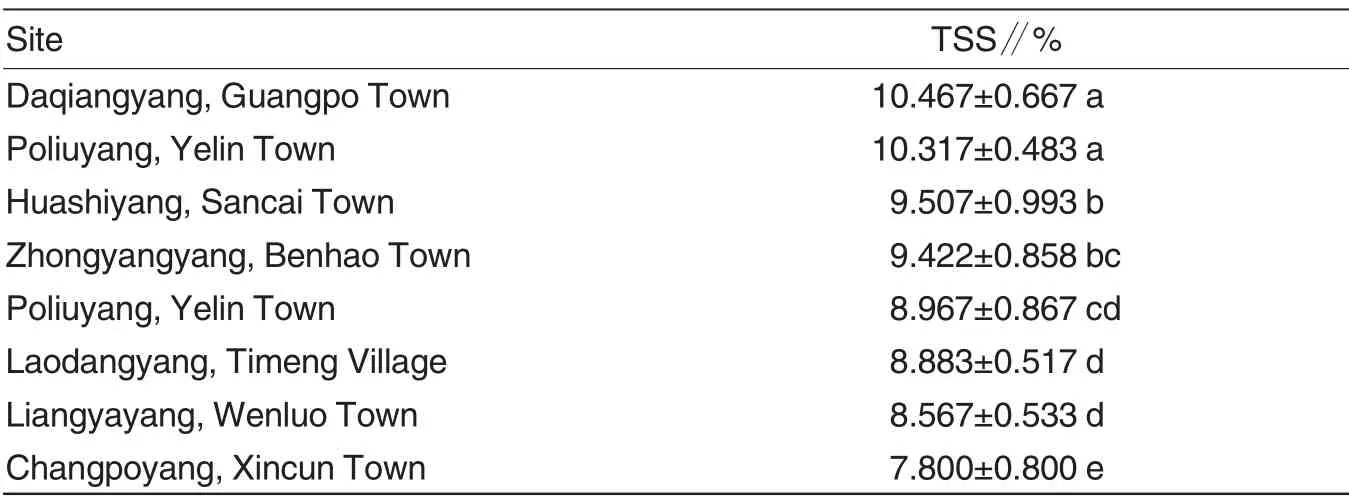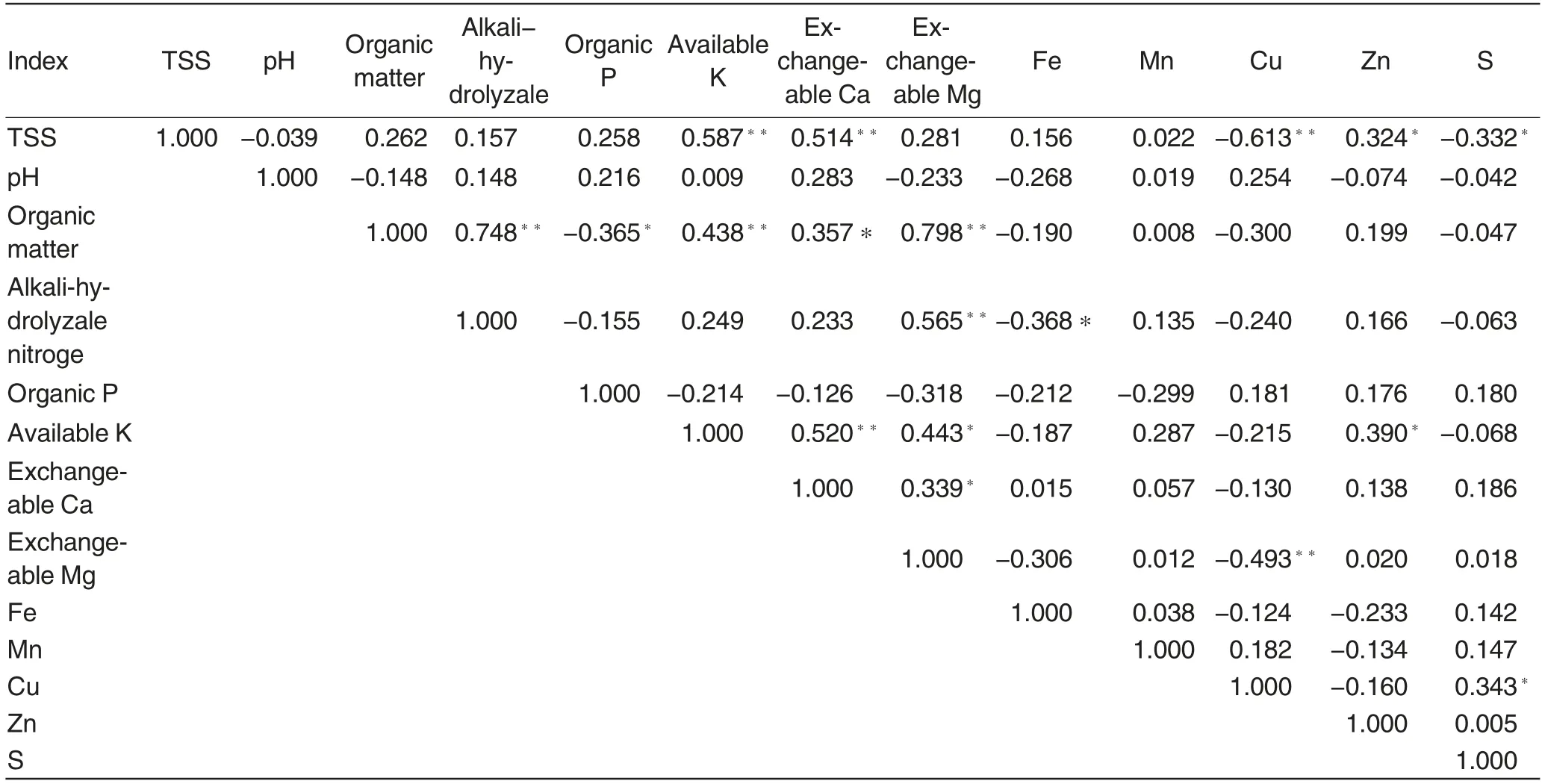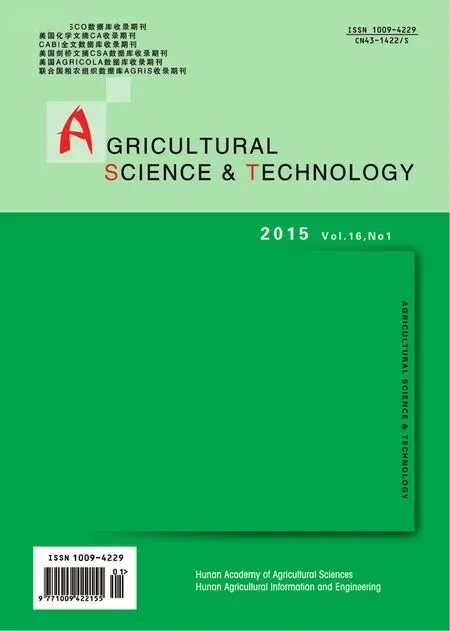Effects of Different Soil Nutrient on the Soluble Solids Content of Cherry Tomato
Xueshan WAN, Caimin ZHOU, Qing CHEN
Agricultural Technology Bureau of Lingshui County, Lingshui 572400, China
The tomato is one of fruits and vegetables the most extensively cultivated worldwide.While it is botanically a fruit, it is considered a vegetable for culinary purposes. It contains 13 vitamins and 17 mineral substances,abundant with Vc,and lycopene content proves the highest. Hence, the tomato is one of fruits as well vegetables enjoying higher nutritional value. Currently, the tomato is widely cultivated in China.For example,Lingshui County,Hainan Province, has become national production base of cherry tomato, with growing cultivation area. What’s more, the goal of fruit and vegetable production has changed from yield into quality improvement[1].Additionally,the content of nutrients of soils has effects on tomato growth[2]. Recently, researches have been conducted on the effects of soil nutrients on quality of horticultural plants, with progress. For instance,Li et al.[3]explored the relationship between soil nutrients and fruit quality in Xinken apple gardens,Mayan District. Cheng et al.[4], Fallahi et al.[5], Hilmelroch et al.[6]and Palmer et al.[7]made exploration on correlation between soil nutrients and apple quality. Bao et al.[8]investigated the status of soil nutrients in Newhall navel orange garden in Hubei Province and the effects on fruit quality, proposing that TSS content showed linear correlation with the contents of available P and available K.Ma et al.[9]researched that the increase of P fertilizer would improve the content of soluble sugar in tomato and the increase of K fertilizer would improve the contents of soluble sugar, Vc and amino acid within certain extent. Ning et al.[10]explored the effects of highly-concentrated K on yield and quality of tomato and pointed out that K fertilizer at 9 mmol/L would increase the content of TSS and K fertilizer at 12 mmol/L would significantly decrease nitrate, and the sugar-acid ratios of K fertilizer increased by 9.67% and 10.70% compared with control group.Zhu et al.[11]investigated that K fertilizer applied in tomato field would improve Vc content and sweetness of tomato. Pan et al.[12]re-searched that proper P fertilizer would advance tomato yield and improve the quality, but both of yield and quality would be decreasing by excessive P fertilizer. Wang et al.[13]explored the effects of steel and iron slag zinc fertilizers on tomato yield and quality,which indicated that the fertilization of N,P and K fertilizers, added with steel and iron slag zinc fertilizers would increase the content of soluble sugar by 4.74% -7.11% . Zhang et al.[14]researched the effects of Mg, B, Zn and Mo on quality and yield of tomato and proposed that Mo fertilizer would increase soluble sugar of tomato, which was contrary to Mg,B and Zn.Yang et al.[15]explored that soluble fertilizers,“Songtian” golden Ca would improve quality of tomato. Zhao et al.[16]investigated the effects of fertilizations on tomato yield and quality and proposed that the fertilization of inorganic fertilizers would maintain high contents of soluble sugar and titratable acid. Cui and Wang researched the effects of fertilization structure on tomato nutrient quality and pointed out that the contents of Vc, and soluble sugar,sugar-acid ratio, and content of nitrate would be increased in the treatment with organic fertilizer, ammonium sulfate, superphosphate and potassium sulphate[17]. Han et al.[18]made investigation the effects of compound fertilizers added with manganese ion on tomato quality and concluded that Mn-AA would improve the contents of Vc,soluble solids,soluble protein and free amino acid,reduce titratable acid content and increase sugar-acid ratio.Researches available are more on fruit trees, but less attention is paid to effects of soil physical and chemical properties on tomato quality. On the other hand, because of regional differences, the standard values concluded from researches tend to be volatile,which will be difficult in leading cultivation of cherry tomato. Hence, it is of great significance for advancing balance fertilization technology, improving fruit yield and quality, and promoting sustainable development of fruit industry to grasp the correlation between cherry tomato quality and soil physical and chemical properties. In order to further explore the correlation between soil nutrients and cherry tomato quality in Lingshui County,Hainan Province, based on field survey and room experiment in 8 cherry tomato producing areas, the correlation between TSS content of cherry tomato and soil properties was explored, which provides references for construction of cherry tomato garden and guidance of cultivations.
Materials and Methods
The test soils were sampled from cherry tomato producing area in Lingshui County, and the test materials were Qianxi grafted cherry tomato,provided by Known You Seed (China)Co. Ltd. Specifically, the plants were grown with planting space at 85cm×60cm, in November 2012, as per local method and the room experiment was in February 2013. During harvest period,the sampling depth maintained 12 cm in different regions to measure physical and chemical properties of soils. Furthermore, TSS content of fruits was measured when the 5th ear matured, and three farmland fields were chosen from every region, with 10 repetitions of every field.
The test data were processed with Microsoft Excel 2003 and analysis of variance and test of significance were conducted as per Duncan method with SPSS 10.0.

Table 1 Physical and chemical properties of test soils
Results and Analysis
Soil physical and chemical properties
As shown in Table 1, pH value of test soils was in the range of 5.10-5.85, of which the value in Changpoyang, Xincun Town, reached the highest,and in Poliuyang, Yelin Town,Laodangyang, Timeng Village, and Liangyayang, Wenluo Town were reached the lowest at 5.10. The content of organic matter maintained in 0.800-2.245 g/kg, including maximum of Anmayang, Yelin Town and minimum of Huashiyang, Sancai Town.Alkali-hydrolyzale nitrogen content kept in the range of 36.750-99.600 mg/kg, including maximum of Anmayang, Yelin Town and minimum of Laodangyang, Timeng Village. Thecontent of organic P was in 21.867-96.125 mg/kg, involving the highest of Poliuyang, Yelin Town and the lowest of Liangyayang, Wenluo Town. The content of available K maintained in 14.750 -92.857 mg/kg, including the minimum of Liangyayang, Wenluo Town, and the maximum of Anmayang, Yelin Town. In terms of exchangeable Ca,the content was in the range of 157.100-589.050 mg/kg,and the content achieved the highest in Daqianyang, Guangpo Town, and the lowest in Huashiyang, Sancai Town.Exchangeable Mg content kept in 4.400-38.943 mg/kg, and the content was the highest in Anmayang, Yelin Town and the lowest in Changpoyang,Xincun Town. The content of Fe was from 87.800 to 1 388.025 mg/kg, and was the highest of Liangyayang,Wenluo Town and the lowest in Huashiyang, Sancai Town. The content of Mn was in 8.950-62.100 mg/kg,and reached the peak of Huashiyang,Sancai Town and the lowest of Changpoyang, Xincun Town. The content of Cu was in 2.530-1.665 mg/kg, reaching the highest of Changpoyang, Xincun Town, and the lowest in Anmayang, Yelin Town. The content of Zn changed in the range of 5.095-13.131 mg/kg,achieving the highest in Anmayang,Yelin Town and the lowest in Laodangyang, Timeng Village. The content of S maintained in the range of 4.825 -34.100 mg/kg, reaching the highest of Changpoyang,Xincun Town and the lowest of Zhongyangyang,Benhao Town.
TSS content of cherry tomato
The contents of TSS in Daqiangyang, Guangpo Town and Anmayang, Yelin Town were 10.467%and 10.317%, respectively in Lingshui County, Hainan Province, with insignificant differences, followed by Huashiyang,Sancai Town and Zhongyangyang, Benhao Town at 9.507%and 7.422% , with little differences,showing significant differences with that in other regions. The content of Poliuyang, Yelin Town, was 8.967%,ranking the 3rd, showing insignificant differences with Laodangyang,Timeng Village and Liangyayang, Wenluo Town and significant differences with that in other regions. The contents of TSS in Laodangyang, Timeng Village and Liangyayang, Wenluo Town were 8.883% and 8.567%, respectively, showing insignificant differences with that of Poliuyang,Yelin Town and significant differences with that of other regions.The content of Changpoyang,Xincun Town was the least at 7.800%,with significant differences with that of other regions.

Table 2 TSS contents of cherry tomato

Table 3 Correlation of TSS content of cherry tomato with soil physical and chemical properties
Relationship of TSS content of cherry tomato with soil physical and chemical properties
As shown in Table 3,TSS content was of extremely significant positive correlation with the content of exchangeable Ca,with correlation coefficients at 0.587**and 0.514**,of significantly positive correlation with the content of Zn, with correlation coefficient at 0.324*, of extremely significant negative correlation with the content of Cu, with correlation coefficient at -0.613**, and of significantly negative correlation with the content of S, with correlation coefficient at-0.332*.
Conclusions
In the research, available K made the largest contribution of the accumulation of TSS content, which coincides with researches made by most scholars on other horticultural plants,namely, available K would advance the accumulation of TSS in fruits. Furthermore, the effects of exchangeable Ca proves higher on TSS content of cherry tomato, which is in consistent with that of Yang ’s[11], and Zn would promote the increase of TSS in cherry tomato also, which is similar to that made by Zhang et al.[10]. The research explored that S played a more powerful role in inhibiting TSS accumulation of cherry tomato, and organic P had inhibition effects on TSS accumulation,which are different with that made by Bao et al.[8]or by Ma et al.[9], possibly caused by sensitivity degrees of researched species. What’s more, in some regions in the research, S content was higher, which was in consistent with that of Pan’s[12], possibly caused by inhibition on other elements,and the most suitable content of P in soils requires further exploration. In terms of trace elements, the research incorporated that Mg, Zn and Mn would increase the content of TSS,which is different with that made by Zhang et al.[14],but similar to that made by Han et al.[18]. Qi et al.[19]proposed that common effect of invertase and sucrose synthetase is a major factor influencing sugar accumulation in tomato, and more exploration requires on the range of nutrient elements, and the relationship of the content of available K,exchangeable Ca,and Zn,with invertase and sucrose synthetase. It can be concluded that within a certain extent,it is key for improving quality of cherry tomato in Lingshui County,Hainan province to increase the contents of available K, exchangeable Ca and Zn.
[1]SORENSEN J N, BURNS I G, BENDING G D,et al.Nitrogen effects on vegetable crop production and chemical composition[J].Acta Horticulturae,1999,506:41-49.
[2]ARVIDESSON J. Nutrient uptake and growth of barley as affected by soil compaction [J]. Plant and Soil, 1999,208(1):9-19.
[3]LI BG(李保国),QI GH(齐国辉),GUO SP(郭素平),et al.Study on the relationship between the soil nutrient elements and the apple fruit quality of the newly reclaimed apple orchard in Taihang mountain gneiss area (太行山片麻岩区新垦苹果园土壤营养与果实品质的关系研究)[J]. Chinese Journal of Eco-Agriculture (中国生态农业学报), 2002, 10(3):17-20.
[4]CHENG L, RABA R. Accumulation of micronutrients and nitrogen demandsupply relationship of ‘Gala’/M.26 trees grown in sand culture [J]. Journal of American Society for Horticultural Science,2009,134(1):3-13.
[5]FALLAHI E, COLT W M, FALLAHI B.Optimum ranges of leaf nitrogen for yield, fruit quality and photosynthesis in BC-2 Fuji apple[J].Journal of American Pomological Society,2001,55 (2): 68-82.
[6]HILMELROCH D G, WALKER C E.Seasonal trends of calcium magnesium,and potassium fractions in apple leaf and fruit tissues [J]. Journal of the America Society for Horticultural Science,1982,107:1078-1080.
[7]PALMER J W,DRYDEN G.Fruit mineral removal rates from New Zealand apple(Malus domestica) orchards in the Nelson region[J]. New Zealand Journal of Crop and Horticultural Science,2006,34:27-32.
[8]BAO JF (鲍江峰), XIA RX (夏仁学),PENG SA (彭抒昂),et al.Main soil nutrient status of Newhall orchards of Hubei Province and its effect on fruit quality of Newhall orange(湖北省纽荷尔脐橙园土壤营养状况及其对果实品质的影响)[J]. Soils(土壤), 2006, 38(1): 75-80.
[9]NING XJ (宁秀娟),YU HJ (余宏军),JIANG WJ (蒋卫杰),LIU XR (刘啸然),YANG XY (杨学勇).Effects of different potassium levels applied at blooming stage on the growth,yield and quality of tomato in greenhouse (不同钾水平对温室番茄生长、产量和品质的影响)[J].Soil and Fertilizer Sciences in China(中国土壤与肥料),2011,6:35-38.
[10]MA Y(马跃),TIAN JQ(田建全),YIN XL(尹晓丽),LI GB(李国斌),HAN J(韩静),WANG SZ(王树志).Effects of N,P and K proportions on quality of tomato in greenhouses (氮磷钾配比对温室番茄品质的影响)[J]. Northern Horticulture(北方园艺),2011,18:57-60.
[11]ZHU JH(朱静华),LI YH(李玉华),GAO W (高伟), LI MY (李明悦). Effects of potassium fertilizer on tomato yield,quality and potassium cycling in greenhouse(钾肥对保护地番茄产量、品质和钾素循环规律的影响)[J].Tianjin Agricultural Sciences (天津农业科学),2013,19:17-21.
[12]PAN KK (潘可可), LIU EL (刘恩玲),ZHU JQ(朱剑桥),SUN J(孙娟),LU SY(卢圣佑),HU GH(胡国辉).Effects of P fertilizers on tomato yield and quality(磷肥不同施用水平对设施番茄产量、品质的影响)[J]. Shanghai Agricultural Science and Technology (上海农业科技),2011,6:113-115.
[13]WANG XJ(王秀娟),LOU CR(娄春荣),LIU HY (刘慧颖), et al. The effect of steel and iron slag zinc fertilizers on fruit yield and quality of tomato(含锌钢铁渣肥对番茄产量和品质的影响)[J].Soil and Fertilizer Sciences in China(中国土壤与肥料),2008(1):63-65.
[14]ZHANG J (张剑),TANG XC (唐筱春),CHEN J (陈军). Effects of Mg, B, Zn and Mo on quality and yield of tomato in greenhouses (镁硼锌钼营养对大棚番茄品质与产量的影响)[J].Journal of Anhui Agricultural Sciences (浙江农业科学),2009(5):879-881.
[15]YANG YP (杨玉萍).Effects of “Songtian”soluble fertilizers on tomato (“松田”牌巨金钙可溶性肥料在番茄上的应用效果试验示范初报)[J]. Shaanxi Journal of Agricultural Sciences (陕西农业科学),2007(1):29,63.
[16]ZHAO M(赵明),CAI K(蔡葵),SUN YH(孙永红),et al.Influence of organic and chemical fertilizers on tomato yield,quality, and the content of available heavy metals in soil ( 不同施肥处理对番茄产量品质及土壤有效态重金属含量的影响)[J]. Journal of Agro-Environment Science(农业环境科学学报),2010,29(6):1072-1078.
[17]CUI WF(崔文芳), WANG JC(王俊超).Effect of different fertilization structure on nutritional quality and sulfate nitrate of tomato(不同施肥结构对番茄营养品质和硝酸盐含量的影响)[J].Journal of Changjiang Vegetables(长江蔬菜(学术版)),2008(9):33-36.
[18]HAN DF(韩冬芳),HUANG PZ(黄培钊),WANG DH (王德汉),DUAN JX (段继贤),GE RS(葛仁山).Effect of different morphology manganese on yield and quality of tomato(不同形态锰对番茄产量及品质的影响)[J].Chinese Agricultural Science Bulletin (中国农学通报),2011,27(13):268-271.
[19]QI HY(齐红岩),LI TL(李天来),ZHANG J (张洁), et al. Relationship between carbohydrate change and related enzymes activities during tomato fruit development (番茄果实发育过程中糖的变化与相关酶活性的关系)[J]. Acta Horticulturae Sinica (园艺学报),2006,33(2):294-299.
 Agricultural Science & Technology2015年1期
Agricultural Science & Technology2015年1期
- Agricultural Science & Technology的其它文章
- Optimization Model of the Effects of Transplanting Density,Nitrogen and Potassium Fertilization on Yield and Quality of an Aromatic Hybrid Rice "Luyoumingzhan"
- Effects of Anti-wind Erosion with Peanut Stubbles in Sandy Lands during Fallow Period
- Analysis on Resistance of Rice Cultivar Lianjing 7 to Rice Black-streaked Dwarf Disease
- Reduction of Cd,Cu,Ni and Pb Mobility by Active Si
- Seed Morphology and Seedling Variation of Four Ornamental Lupin Pedigrees
- Effects of Planting Density on Yield and Mechanical Harvesting Loss Rate of Brassica napus L.
